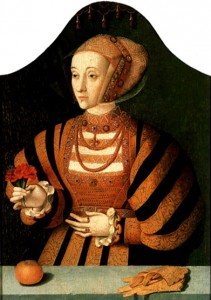 On this day in history, the 22nd September 1515, Anna von Jülich-Kleve-Berg, or Anne of Cleves, was born near Düsseldorf. She was the second daughter of John III, Duke of Jülich, Cleves and Berg, an important German ruler, and Maria of Jülich-Berg. Anne had royal blood; not only was she descended from Edward I, she was also, on her father’s side, closely related to Louis XII of France and the Duke of Burgundy.
On this day in history, the 22nd September 1515, Anna von Jülich-Kleve-Berg, or Anne of Cleves, was born near Düsseldorf. She was the second daughter of John III, Duke of Jülich, Cleves and Berg, an important German ruler, and Maria of Jülich-Berg. Anne had royal blood; not only was she descended from Edward I, she was also, on her father’s side, closely related to Louis XII of France and the Duke of Burgundy.
In 1526 Anne’s elder sister, Sybille, married John Frederick I, Elector of Saxony and Head of the Protestant Confederation of Germany, and in 1527, Anne’s father arranged for Anne to marry Francis, the heir of the Duke of Lorraine. This betrothal was broken when Anne’s brother, who became Duke of Jülich-Cleves-Berg on the death of his father in 1538, refused to give up the territory of Guelders to the Duke of Lorraine in 1539.
The Schmalkaldic League, an alliance of Lutheran Princes established by Anne’s brother-in-law, John Frederick I, Elector of Saxony, had been trying to establish a relationship with England in the late 1520s, and in 1531 sent ambassadors to Henry VIII. The Duke of Cleves, Anne’s father, had also been involved with marriage negotiations with England in 1530, although Henry had chosen to marry Anne Boleyn. These marriage negotiations were resurrected in January 1539 when Henry was looking for a fourth wife, following the death of Jane Seymour (1537). Henry’s chief advisor, Thomas Cromwell, was keen to build links with the Schmalkaldic League, and when Henry saw that Francis I of France and Charles V, Holy Roman Emperor, were becoming friendly, he too looked towards Germany for support.
By the end of September 1539, a marriage treaty between England and Cleves had been agreed upon, and preparations were made for Anne to travel to Calais and then on to England. Anne arrived in England on the 27th December 1539, and the royal couple were married on the 6th January 1540, at Greenwich Palace. It was not to be a happy marriage, and just over 6 months later the marriage was annulled, and Henry VIII married his fifth wife, Catherine Howard. Anne became known as the King’s sister, and was rewarded for her acquiescence with £4000 per year and houses at Richmond, Bletchingley and Lewes. She was also given Hever Castle, jewels, plate, hangings and furniture. She kept her head and became a wealthy woman.
Anne of Cleves outlived Henry VIII and all of his other wives, dying on 15th July 1557, aged 41.
(Extract taken from On This Day in Tudor History by Claire Ridgway)
See The Schwanenburg, Castle of the Dukes of Cleves for Elena Homburg’s beautiful photos of Swan Castle (the Schwanenburg), the former home of the Dukes of Cleves, the family of Anne of Cleves, and where Anne lived before she travelled to England to marry henry VIII.